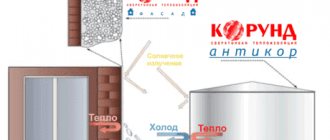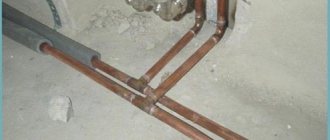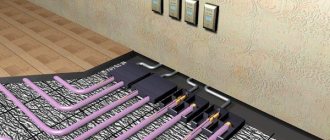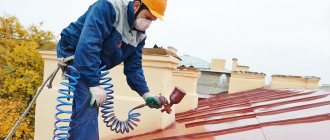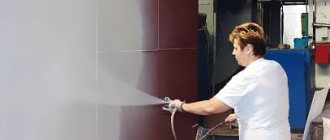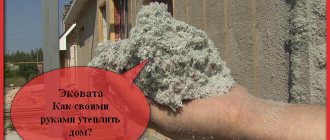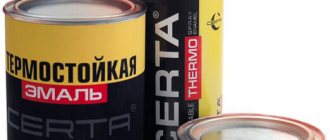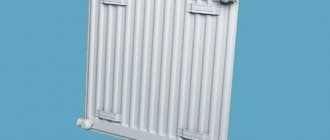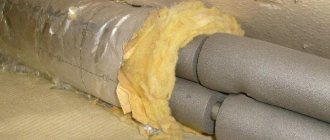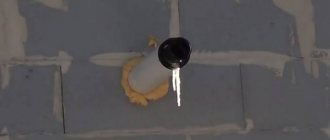To avoid heat losses in the heating system, it is necessary to take care of the thermal insulation of its elements. Liquid thermal insulation Corundum, a polymer coating, helps solve this problem. After drying, it turns into an elastic and impermeable protective layer that is resistant to environmental factors.
Its technical characteristics are impressive: Corundum does not deteriorate when in contact with chemicals, when exposed to direct sunlight or when heated to several hundred degrees. This heat-insulating paint is safe for people, and it will give the painted surface an aesthetic appearance.
Production features and general description
Thermal insulation Corundum is a composition based on ceramic microspheres and an acrylic binder. The last ingredient is produced using catalysts and fixatives.
The size of the microspheres varies from 0.01 to 0.5 mm. The composition of the product is also supplemented with all kinds of additives to enhance its performance properties. This composition gives the material flexibility, lightness and elasticity. In addition, Corundum is characterized by good adhesion to a wide variety of surfaces.
The consistency of this brand of heat insulator resembles ordinary paint. In fact, it is a white suspension, which, after hardening, forms a very reliable and elastic polymer coating.
In comparison with ordinary heat-insulating materials, Corundum provides not only protection against heat loss, but also against corrosion .
Initially, such coatings with heat-protective properties were created at the request of NASA for finishing spacecraft. Over time, experts adapted these mixtures for “earthly” needs. Corundum is the commercial name of a product that was developed by Russian specialists. This heat insulator has special certificates that indicate its high quality.
Differences in paint materials
Having examined all the compositions, we can conclude that enamels have pigmented components as their base, while paint has binding elements. Enamels contain only organic solvents. There are differences in physical and chemical characteristics. Also, enamel differs from paint in that enamel is harder and more elastic. But the coating is much thinner. But they have much less impact from temperature changes. Therefore, enamel is used for domestic purposes. It also has many shades and a huge selection of colors. Decoration is much more varied and interesting. Return to list
Types of heat insulators Corundum
Today you can find several modifications of this product on sale. Of these, the most popular are the following formulations:
- Classic . This is a very effective product designed for insulating walls (outside and inside), pipelines, roofs, facades, air conditioning systems, and steam pipelines. Thermal paint prevents the formation of condensation on surfaces and also reduces heat loss.
- Antikor . This type of insulation is notable for the fact that the material can be applied even to metal surfaces with traces of rust. In addition, Antikor has excellent thermal insulation properties.
- Winter . This material can be used even at sub-zero temperatures. Corundum Winter does not harden or freeze at low temperatures. The mixture includes foam glass microgranules and acrylic polymers. In addition, they contain inhibitors, pigments, flame retardants and rheological elements.
- Facade . This thermal insulation material is intended for treating concrete bases. Has high heat-reflecting characteristics. The product can be applied even in a thick layer, which makes work faster. Thermal insulating paint Corundum Facade is characterized by high resistance to climatic influences and vapor permeability.
Insulation or heat insulator
Being a complex multi-level structure that minimizes existing methods of heat transfer, the heat insulator is of increased interest: “Is corundum an insulation or a heat insulator?”
However, these concepts should be distinguished. The operating principle of insulation is based on the physical thermal conductivity of the material. Therefore, the effectiveness of insulation depends on the thickness of the insulation. The operating principle of a heat insulator, on the contrary, is based on wave physical properties. The thickness of corundum ultra-thin thermal insulation ranges from 1 to 6 mm. The shocking limits of the minimum thin thickness of the insulation layer are, perhaps, the main advantage of Corundum over existing thermal insulation materials.

Specifications
The properties of this material allow it to be used for processing structures for various purposes and different configurations.
The characteristics of Corundum should be considered in more detail:
- Low degree of thermal conductivity. This indicator for the Corundum heat insulator is much lower than that of most classical materials, such as mineral wool or polystyrene foam.
- Moisture resistance. Corundum does not allow moisture to pass through its structure and is not damaged by it. This brand of heat insulator is not even afraid of saline solutions.
- Fire resistance . The heat insulator Corundum does not burn. When exposed to high temperatures, it decomposes, releasing nitrogen and carbon oxides.
- Vapor permeability. This type of paint does not form an airtight film on the surface. It provides effective air exchange, creating an optimal microclimate in the room.
- UV resistance. The structure of the material is not damaged by exposure to the sun's rays. Therefore, it can be used even without additional protection.
- Biostability . Rot, fungi and mold will not appear on elements that are treated with Corundum thermal paint. The material is not afraid of rodents and insects.
- Ecological cleanliness. Liquid heat insulator does not release toxins into the environment even with strong heating. You can work with it even without using personal protection.
- Durability . This coating has a long service life. It does not lose its operational properties for 10-15 years. No defects or cracks appear on it.
Dye for normal and thick (coarse) hair
For strong, normal and coarse hair, permanent and semi-permanent professional dyes with a gentle formula that does not damage the hair structure may be suitable.
The paint should not injure the bulbs and scalp. Therefore, they should contain vitamins, plant extracts, waxes and oils to improve blood circulation and nourish hair, protect against ultraviolet radiation and retain moisture.
It is better to choose a rich dye that changes the natural color by 3-6 shades and covers gray hair.
The following professional products are suitable for coarser and thicker hair:
- Goldwell Kerasilk Ultra Rich Care line with silk proteins. The product moisturizes, strengthens and restores hair structure, has a particularly beneficial effect on dry and damaged hair;
- premium German cosmetics GOLDWELL, the colors of which have a wide range of styles and new technologies;
- AWESOMECOLORS line with a wide palette of permanent and semi-permanent colors, including the unique Silky-Shine Complex product with effective protection: three wheat proteins, vitamin C, extracts and oils from medicinal herbs, beeswax and candepil wax. After dyeing, the hair combs well, shines, and becomes elastic.
Advantages and disadvantages of the material
Thermal paint of this brand carefully fills the micropores of the surface that is being processed. In addition, liquid thermal insulation has the following advantages:
- Retains heat perfectly. Even 1 mm of the composition can be compared in terms of efficiency with 40 mm of roll-type insulation, for example, mineral wool.
- Easy to apply. The mixture is applied to the surface like regular paint: with a roller, brush, or spray. At the same time, it does not emit any harmful substances, so it is not necessary to use protective equipment when working with it.
- Provides protection against destruction. Metal surfaces treated with Corundum will never rust, and wood will not dry out or rot.
- Does not attract rodents, insects and bacteria. The coating will not mold or rot.
- Small mass. The weight of the heat insulator cannot be compared with classic rolled material. This type of thermal insulation will not load the foundation and supporting structures. Therefore, even fragile and unstable elements can be treated with Corundum.
- No cold bridges or seams. Using Corundum you can create a reliable coating without any seams.
- Durability and safety. During the entire service life, no harmful chemical compounds will be released from the material. Therefore, they can also insulate living spaces where allergy sufferers live.
- Does not affect geometry. Compared to traditional materials for thermal insulation, Corundum does not have any effect on the geometric parameters of the building.
This type of isolation is not without its disadvantages. First of all, this concerns high cost . This material appeared on the Russian market relatively recently, which is why it still has a high cost. However, this “minus” is fully compensated by the durability of the coating and excellent thermal insulation properties.
The disadvantages also include the rapid polymerization of thermal paint, so you will have to work with it very quickly.
Technology: how to properly paint metal surfaces outdoors
It would seem that there is nothing complicated - take a brush and apply a layer. But a lot depends on the preparation of surfaces and the correct choice of paints and varnishes. If you choose a paint that is not suitable for a certain type of metal, it will quickly crack.
Paint for painting metal surfaces outdoors must contain anti-corrosion substances, preferably with rust converters.
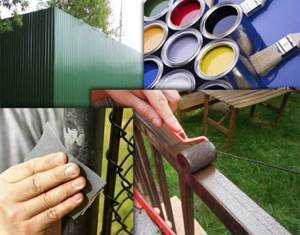
How to determine the quality of metal
Most often, fences and other structures are made of black iron, which quickly rusts. To slow down the oxidation process, coat the parts with alkyd primer.
Galvanized metal parts, especially roofs, are painted with alkyd paint.
As for non-ferrous metals (for example, copper is a red metal), they are almost not painted; in extreme cases, they are coated with varnish (epoxy or polyurethane).
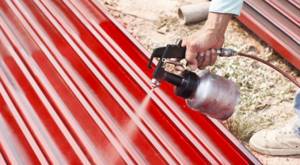
Sequence of work execution
If the damage is minor, before starting work, treat the metal surface with a degreasing solution, then the paint will “adhere” well and adhere to the base material.
If the metal is covered with a thick layer of rusty deposits, remove it with a special metalworking tool (scraper). Using a pointed tip, you can remove a layer up to 0.01 mm thick.
There is no need to strip everything down to the base; a thin, uniform layer of rust is acceptable.
If you don’t have a scraper, you can use sandpaper or a brush with metal teeth. A simple metal sponge is suitable for cleaning lightly damaged parts.

You can not remove the rust, but treat it with orthophosphoric acid (included in some solutions) and apply a layer of paint on top. Phosphoric acid is best used in advanced cases.
Important! Before treating metal with any chemicals, wear gloves and a respiratory mask. After removing rust and treating parts with solvents and degreaser, wait until the structure dries
Do not apply paint to a wet structure
After removing rust and treating parts with solvents and degreaser, wait until the structure dries. You cannot apply paint to a wet structure.
It is recommended to wash the structures with plain water and soap.

Which paint is suitable for untreated surfaces:
- The composition contains corrosion inhibitors, substances that slow down the formation of rust.
- The thickness of the protective film is at least 150 microns.
The next step after drying is priming the surface. The primer provides additional protection and enhances adhesion to the material (it is recommended to apply 2 layers).
For ferrous metal, take an anti-corrosion primer, for non-ferrous metal, a mixture with good adhesive ability or varnish.
After the primer has dried, you can begin applying paint.
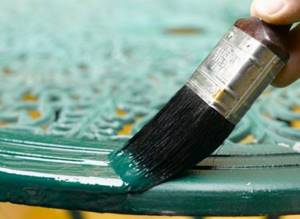
The nuances of coloring
It is more convenient to paint twisted fences, fences or decorative figures made of iron with a brush - it will get into all hard-to-reach places and paint over small details.
Apply several layers (wait for the first to dry before applying the second).
The number of layers depends on how well the surface was treated and what compounds were used. If there was no pre-treatment or cleaning, then more paint will be needed.
It is easier to paint small areas with an aerosol can, the main thing is not to interrupt during application - the stream should be continuous, and the distance of the spray from the surface should not be more than 20 cm. At least 3-4 layers will be needed.
Before spraying again, you need to wait for the previous layer to dry (about 15 minutes).
It is better to paint metal surfaces over large areas (for example, roofs) with a wide, but not very hard roller. If you paint hard, you will have to go back and paint over the missed areas.
You need to add a solvent to the enamel for exterior use (10% of the volume of the jar).
The maximum number of layers is 3.
Use a roller to paint only a flat surface; corners and joints are painted separately with a brush. Dip the roller into the paint tray, press lightly against the mesh (to avoid splashing) and bring it to the wall or metal surface. The movements need to be made up and down, and the strips themselves should be placed on top of each other with a slight overlap.

Criterias of choice
The patent for the material belongs to. This organization has several official dealers, for example, “ServisInvestProject”, “TeploTrade” and others. You should not buy products from sellers with a dubious reputation.
The normal state of this brand of material is a white pasty mixture. Packaging: buckets made of durable plastic with different volumes. In this case, information about the manufacturer must be indicated on the packaging.
The cost of thermal insulation varies depending on the region of sale and the type of material. The average cost of insulation is as follows:
- Classic - 390 rubles per liter;
- Anticorrosive - 440 rubles per liter;
- Winter - 560 rubles per liter container.

